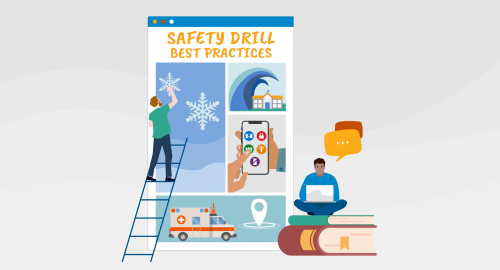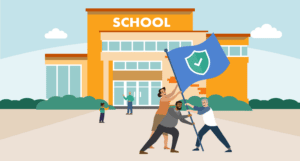Listen to this blog
4 minutes
While emergencies are unpredictable, one of the most effective ways to respond swiftly and efficiently is to be well-prepared. As Dr. Jaclyn Schildkraut, Associate Professor of Criminal Justice at the State University of New York Oswego, puts it in a Raptor webinar, “Our minds go blank during emergencies and our bodies do what they’re trained to do.”
Practice makes prepared—so let’s dive into the best practices for school safety drills:
1. Scheduling Drills for Maximum Effectiveness
Ensuring the safety of students and staff requires meticulous planning and scheduling. The timing, frequency, and nature of drills play a pivotal role in preparing everyone for potential emergencies. Here’s how to make the most out of your safety drills:
- Plan in Advance: Determine scenarios, decide on the location, duration, time, and frequency of the drills. Stay compliant with district and state mandates.
- Diversify Timing: Emergencies don’t wait. Whether it’s during class, lunch, or recess, students need to be prepared. Consider all potential situations.
- Inform in Advance: The school community should be aware of planned drills. However, sporadic ‘stop and think’ drills, as described by school safety expert Paul Timm, can be beneficial. These spontaneous drills can be conducted during unpredictable times, like during arrival or lunch.
2. Types of Drills to Consider
Not all drills are created equal. Different situations call for different types of drills, each tailored to simulate specific emergencies. By diversifying the drills, schools can ensure comprehensive preparedness. Here are some types of drills to consider:
- Tabletops: Interactive scenarios with small groups.
- Walk-through drills: Slow-paced simulations for students.
- Simulation Drills: Creating a realistic environment for emergencies.
- Full-Scale Simulations: Comprehensive scenarios involving multiple emergency situations.
In addition to the above best practices, ask different staff members to initiate drills, and have them do so at different times and locations. For example, if your staff are used to the secretary announcing lockdown drills over the intercom at 9 am, they should learn how to react when the 3rd grade math teacher initiates one via the Drill Manager module in the Raptor Alert app at lunchtime or from the playground.
3. Execution Matters
“I want to commend your teachers and administrators at Robinson Elementary for their expert execution of a fire drill that I observed. Today, I saw the most organized and well-run drill that I’ve ever seen in my many years as a fire Marshall. I watched students that knew exactly what to do and where to go, and teachers and administrators that moved quickly and calmly to secure the students out of the building. I then observed the teachers taking role of students on their phones and was curious… “What are they doing?” I asked several questions about the system and what it was capable of including notifications, accountability, and reunification. The staff was beaming with pride in how fast they had assembled students and accurately accounted for them. I normally witness complaining and general apathy when drills are conducted. This was not the case today. I commend your staff for a job well done!“
Robinson, TX Fire Marshall
The effectiveness of a drill is determined not just by its planning, but also by its execution. A well-executed drill can be the difference between chaos and order during a real emergency. Here’s what to keep in mind during the execution phase:
- Take It Seriously: Every drill, no matter the scenario, should be treated with utmost seriousness.
- Inclusive Participation: Every staff member, irrespective of their role, needs to participate.
- Engage First Responders: Collaborate with law enforcement and other emergency services for a well-rounded response plan.
4. Feedback & Assessment
Post-drill assessments are crucial for continuous improvement. Gathering feedback, analyzing data, and refining the process ensures that each drill is more effective than the last. Here’s how to make the most of your post-drill assessments:
- Debrief: After each drill, gather feedback from teachers, students, and public safety officials.
- Use Data: Utilize technology to collect and analyze performance data. This aids in refining the drills and ensures compliance with regulations.
Raptor Drill Manager enables schools to manage and track drills as well as review reports on drill performance so your district can learn and improve as well as eliminate compliance risks.
5. Incorporate Comprehensive Training Curriculum
Beyond drills, a comprehensive training curriculum ensures that students and staff are equipped with the knowledge and skills to handle emergencies. A well-managed reunification can make a significant impact on reducing the trauma of a school emergency.
From the language used to the simplicity of the program, every detail matters. Here’s how to build an effective training curriculum:
- Targeted Training: From active shooter training to everyday incidents, have a well-rounded curriculum that empowers students and staff.
- Language Matters: Use words that align with the school’s ethos and that resonate without instilling unnecessary fear.
- Simplicity Is Key: Effective programs are easy to remember, adaptable, and reviewed regularly.
The “I Love U Guys” Foundation and Raptor Technologies offer Together Reunification Exercise (T-REx), an exclusive, best-in-class reunification training program so schools can gain the knowledge and confidence in their ability to be successful when the need arises. The cohesive training curriculum removes any guesswork about how the technology and methodology work together.
The driving force behind the Joint Reunification Training program is to help schools break down the barriers to effectively practicing their plans by bringing all stakeholders together to build confidence among their teams to be successful when the need arises.
Be Better Prepared with Raptor
Back-to-school should be a time of excitement and learning. By integrating these drilling best practices, we can make our educational spaces safer and more secure, ensuring that the focus remains on education, growth, and development.
Raptor can help. Learn more strategies, more best practices for effective school safety drills.
Related Resources
Guide to K-12 Emergency Management
Proven Strategies to Protect Your School
Listen to this blog
4 minutes








